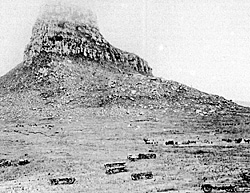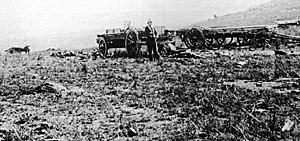 "The name they made will never fade and all with pride will tell,
"The name they made will never fade and all with pride will tell,
How England's gallant Twenty-Fourth as heroes fought and fell."
COL. W. BLACK
"RORKE'S DRIFT, 28th June, 1879. "The force under my command-thirty King's Dragoon Guards (mounted), fifty on foot, 140 2-24th Regiment, 360 natives, and fifty Native Horse, were working on the 20th, 23rd, and 26th inst., and have completed the burial of the remains of those who fell at the battle of Isandlwana. Major Dartnell, with some Natal Mounted Police, and representatives from the Natal Carbineers, Buffalo Border Guard, and other volunteers, co operated with me on the first day, and looked after the burial of their own comrades. As I reported in March last, the bodies of the slain lay thickest on the 1-24th camp; a determined stand had evidently been made behind the officers' tents; and here an eye-witness told me that while he was escaping from the camp he saw a compact body of the 24th men fighting, surrounded by Zulus; seventy dead lay here.
Lower down the hill in the same camp another clump of about sixty lay together, among them Captain Wardell, Lieutenant Dyer, and a captain and subaltern of the 24th unrecognisable. Near at hand were found the bodies of Colonel Dumford, Lieutenant Scott, and other Carbineers, and men of the Natal Mounted Police, showing that here also our men had gathered and fought in an organised body. This was evidently a centre of resistance, as the bodies of men of all arms were found converging as it were to the spot, but stricken down ere they could join the ranks of their comrades.
About sixty bodies lay on the rugged slope, under the southern precipice of Isandlwana, among them those of Captain Younghusband, and two other officers, unrecognisable, it looked as if these had held the crags, and fought together as long as ammunition lasted. The proof of hand to hand fighting was frequent; three soldiers were Iying by as many dead Zulus; Zulu and white man confronting each other, as living they had stood. A 24th man was found here, face downward, with a Zulu knife up to the haft in his back, evidently killed while defending himself from a front attack; an assegai bent double lay by him, and another in like state near by. It is bootless, however, to multiply such instances near.
For example, lower down the field an N.M. policeman and a Zulu, the Englishman uppermost, lay still locked in each other's embrace; in another place a Zulu skull was found pierced by a bayonet, while his assegai lay rusting in the white man's breast. Up among the rocks a Zulu chief, covered by his shield, lay swathed in four distinct wrappings of canvas, and as many other Zulu bodies were here. I gather that this was the last scene of resistance, and that, therefore, the Zulus had less time for carrying away their dead, which they have so completely done from the other parts of the field. A soldier of the 24th was found close under the precipice, head downward, with shattered skull showing that he had fallen or been hurled from the top hereabouts, too, was an artillery tent mallet by the side of a soldier, who had vainly matched this feeble club against the assegai.
Many dead lay on the Buffalo side of the neck, and I think it will not be out of place if I describe how the line of retreat led here. When our two lines of infantry, one facing to the left of the camp, in the position naturally taken up after retiring before the chest or main body of the Zulu army, as it swarmed over the Ugulu hill, the other facing more towards the front and parallel to the Donga, making head with the Mounted Volunteers against the Zulu left wing-when these two separate lines of skirmishes, outflanked on both sides, ammunition well nigh expended, retired almost at the same time to rally in the camp, form square around the ammunition waggons, and there refill their pouches, some of those men present tell me that the attention of all being fixed on their own front, none had realised how it fared behind them-once they turned round towards the tents, they saw that all was lost, the camp was full of Zulus, sweeping round the flanks of isolated lines, following through the gap between them made by the retreating Natal natives.
The Zulus were already masters of the place of refuge, while those who had made the front attack now stormed behind the retreating lines. The ordered battle was over, all that disciplined men can do had been done-the lines melted into groups, into files, coherence ceased, friend and foe mingled in one mass, a surging stabbing crowd - their very numbers prevented the Zulus from making an immediate end. The horsemen who escaped, the footmen who struggled through the tents, the very guns moved at a walk wherever a gap opened in the mass, and slowly won their way towards the neck.
Once here, once on the road, the hope of escape arose only to be quenched at the next glance, for circling round the Isandlwana the right horn of the Zulu horde barred the way to Rorke's Drift; the only gap in the ring of steel was the rough ground to the south between the road and the kop that faces the fatal hill. Here, then, of necessity and not of choice, the broken ranks pushed on: Zulus on the kop fired down. Zulus in their midst and Zuius on each flank pressed on with equal pace.
The tracks became rough indeed, scored by dongas, strewn with rocks, seamed with water courses, here dry and stony, with steep sides, there wet and boggy. The horsemen moved on at foot pace, and only escaped because the horse could keep up the exertion longer than the panting foot soldiers. Here to us was the saddest sight, the camp left, the face set toward the Buffalo, all might give hope for life; but the record of death shows heavily here, and not ignobly is it written.
 Here and there around a waggon, here and there around a tree, a group had formed, and stood at bay-shoulder to shoulder they fired their last cartridge, shoulder to shoulder they plied the steel, side by side their bones are Iying, and tell the tale; but other evidence is forthcoming, and I have heard from those who saw and live, how dearly our countrymen sold their lives, how fiercely fighting they fell. 800 yards from the road the guns, long ere this without gunners- they died in the camp-came upon ground that no wheels could pass, and the horses which, on my first visit, I saw hanging in their hamess over a ravine, now mingle theirs with the drivers' bones.
Here and there around a waggon, here and there around a tree, a group had formed, and stood at bay-shoulder to shoulder they fired their last cartridge, shoulder to shoulder they plied the steel, side by side their bones are Iying, and tell the tale; but other evidence is forthcoming, and I have heard from those who saw and live, how dearly our countrymen sold their lives, how fiercely fighting they fell. 800 yards from the road the guns, long ere this without gunners- they died in the camp-came upon ground that no wheels could pass, and the horses which, on my first visit, I saw hanging in their hamess over a ravine, now mingle theirs with the drivers' bones.
From here the bodies are even more and more apart until, about two miles from the camp, the last one lies and marks the limit reached by white men on foot. The fatal trail begins again near the river bank, where Stewart Smith, and others rest a river's breath from Natal; across the river it runs until the graves of Melville and Coghill nearly mark its end.
Of the greater part of those buried, all that can be known is their regiment, for weather and the operations of nature have left but little that is recognisable; where clothes remained, due search was made, but in most cases the pockets had been cut out, and but little property was found by us; that recovered has been sent to the relatives of the slain.
I cannot close my report without calling attention to the hard work so cheerily undergone by the fifty dismounted King's Dragoon Guards, and 140 men of the 2-24th, who each day trudged twenty-two miles to and fro, besides their labour on the widespread field. The natives were principally employed as outposts on the hills, lest peradventure another impi might follow the track of its forerunner across the Ngutu range, or appear on our right from the tunnelled hills between us and the Quadeni.
I need not say that no cross or stone marks the graves of the fallen, above them the Lich Kop, the majestic monument of Isandlwana holds guard, and for ever tells that 800 sons of England lie beneath."
Back to Colonial Conquest Issue 2 Table of Contents
Back to Colonial Conquest List of Issues
Back to MagWeb Master List of Magazines
© Copyright 1992 by Partizan Press.
This article appears in MagWeb (Magazine Web) on the Internet World Wide Web.
Other military history articles and gaming articles are available at http://www.magweb.com